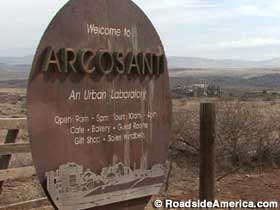
Arcosanti: An Urban Laboratory
Mayer, Arizona
A white silhouette on a large metal disc marks the entrance to the Arcosanti property, depicting a city of impressive futuristic architecture. One searches in vain for this metropolis across the dry range land -- and then notices, off to the right, in the distance, a construction crane. Beneath it, one can barely make out a small cluster of buildings.
This, thus far, is all that exists of Arcosanti, city of the future. Its concrete buildings, some dating back to the days of Nixon and Vietnam, are stained with age. The colors that were fused into them then -- a technique called "silt casting" -- are no longer vibrant.
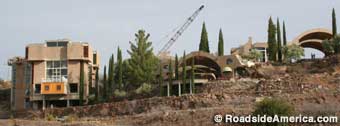
Since the Arcosanti experiment was begun in 1970, only an estimated 5 percent of it has been built. That projects to an estimated completion date of, roughly, 700 years from now.
Still, those hoping to enter some kind of time warp utopia, with tie-dyed flower children weaving plant holders out of macram, will be disappointed. There are no group marriages, no glassy-eyed acolytes. You'd be more likely to find a drum circle in the arts district of your nearest big city than out in Arcosanti.
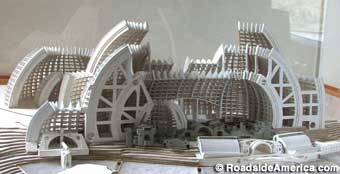
This "prototype arcology" is the vision of Paolo Soleri (1919-2013), an artist/thinker who saw it as an alternative to urban sprawl (Arcology, a word invented by Soleri, means architecture + ecology, and he designed hundreds of them). The completed Arcosanti is intended to house and partly sustain 5,000 people on a mere 25 acres of land -- a more efficient place than, say, Phoenix, the nearest city, which sprawls over 469 square miles. Phoenix, however, exists right now, while Arcosanti currently has a population of less than 100.
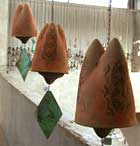
Arcosanti supports itself by giving tours to the curious, and by selling windbells designed by Soleri. This gentle business model is a big reason why Arcosanti hasn't grown as fast as its fans might have liked. The trickle of funds and the glacial building progress, however, do not mean that Arcosanti is a place of repose. Those who live here are expected to work here, either in construction, the greenhouses, in composting and recycling, or, as we saw when we arrived, vigorously washing the cafe windows. Soleri, we were told, did not like hippies.
Tours begin and end in the visitor center/bell shop, where one can see an exhibit of how Arcosanti's master plan has changed, many times, over the years. (Its current incarnation is named Arcosanti 5000.) All of the Arcosantis look alien and spiky, like the bleached exoskeletons of dead sand worms, at least in miniature. Another display asks, "Where are we going to get 19 additional Planet Earths?" and asserts that "The American Dream embodied in the single family house" is "a planetary-human catastrophe." Places like Arcosanti, on the other hand, replace "consumption-gratification unlimited" with "an intense social, convivial, cultural, esthetic, productive, sane life."
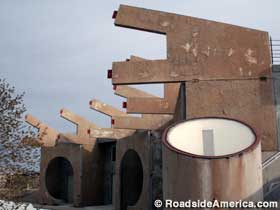
The tour winds its way through the Ceramics Apse (birthplace of the silt cast bells), the Vaults (an arch-shaded plaza), the Amphitheater, the Shopping and Restaurant zone (there are as yet no shops or restaurants), and the Foundry (more bells). Watching molten metal being poured in the Foundry is considered a highlight. Hardier souls can venture out to the greenhouses, or across the dry riverbed to a neighboring mesa, where one can really view how much of Arcosanti has yet to be built.

Although Arcosanti intends to be a city some day, it does not have the manic energy of modern-day urbanization. Its inhabitants seem content to take things at a pace that feels comfortable to them, and to let history judge their efforts -- however far in the future that may be. Our tour guide winced at the word "anachronism" and insisted that Arcosanti's principals are ageless, while the current American model is the aberration. "50,000 people a year come here, look at it, say, 'Wow, isn't that interesting?' and then drive away," he told us, "because it requires a total abandonment of what everyone has taken to be a given."





